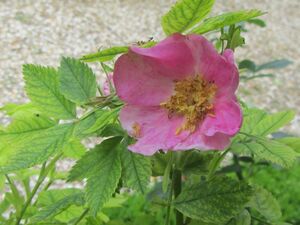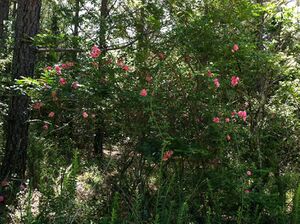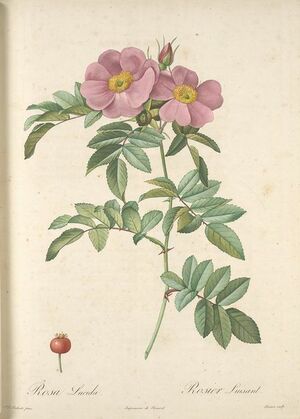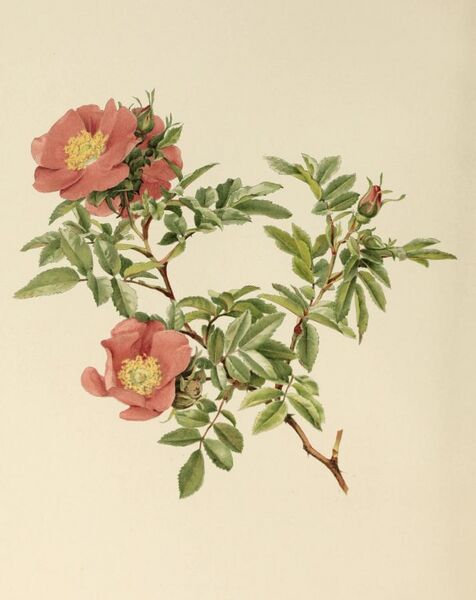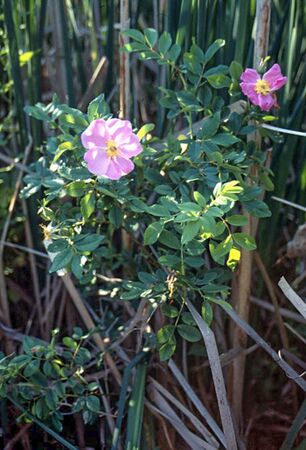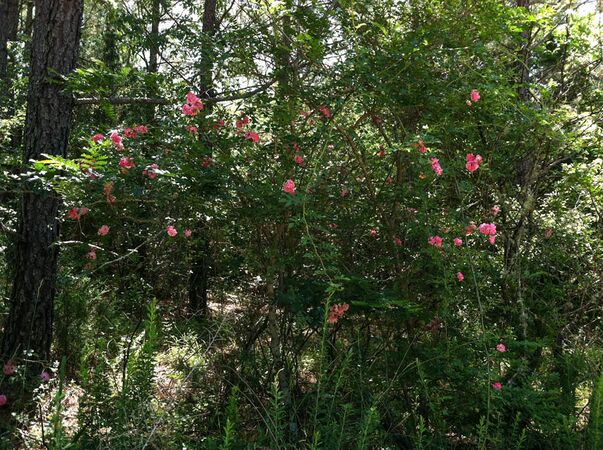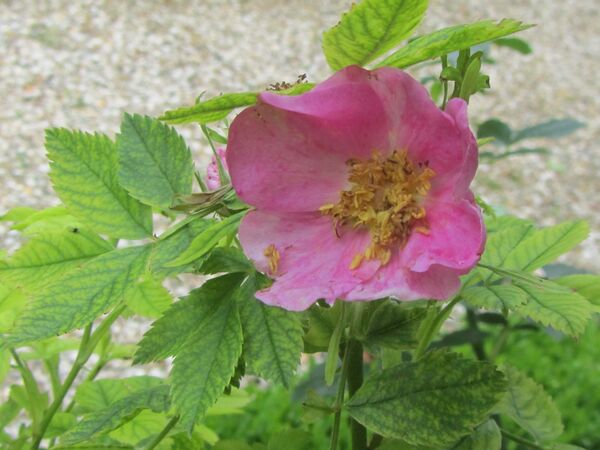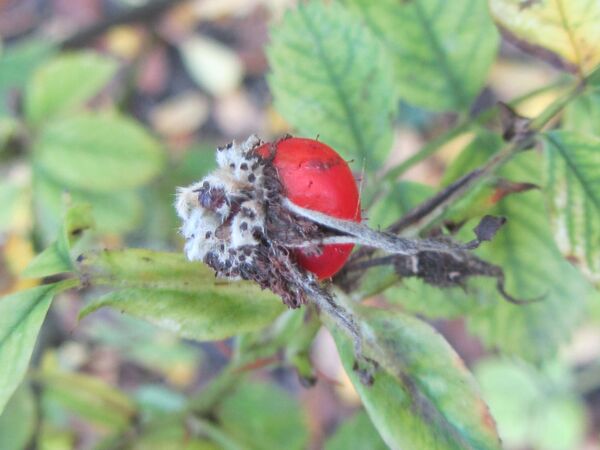Rosa virginiana Mill.
Botanische-Rose, 1768 beschrieben vom Botaniker/ described by the botanist/ rosier décrit par le botaniste Philip Miller, UK, Angleterre. Eine frühere Beschreibung erfolgte bereits 1762 durch den Botaniker/ an earlier description from 1762 by the botanist/ description antérieure de 1762 par le botaniste Paul Hermann, Deutschland, Germany, Allemagne.
Die Synonyme wurden beschrieben von den Botanikern/ synonyms were described by the botanists/ les synonymes furent décrits par les botanistes: William Aiton, John Gilbert Baker, Humphry Marshall, Jakob Friedrich Ehrhart, George Newton Best, Per Axel Rydberg, Alfred Rehder, Paul V. Heath, Paul Hermann.
Eltern/parentage/parents: Wildrose, wild rose, rosier sauvage Sect. 4. Carolinae Crép. – Carolina-Rosen
Synonyme/synonyms/synonymes: Rosa blanda Aiton var. willmottiana Baker, Rosa carolinensis Marshall, Rosa humilis Marshall var. lucida (Ehrh.) Best, Rosa lucida Ehrh., Rosa lucida Ehrh. var. lamprophylla (Rehder) P.V.Heath, Rosa nanella Rydb., Rosa virginiana Herm., Spiegel-Rose, Virginische Hecken-Rose, Virginische Rose, Virginia rose, Rosier de Virginie.
Allgemeines • Preface • Remarques
Die Rose ist heimisch in Nordost Amerika, von Neufundland bis New Jersey. In Flora of North America[1] wird sie als tiefrosa, selten auch weiß beschrieben, ohne hierfür eine Varietät oder Form zu erstellen. Für Botaniker ist offensichtlich die Farbe einer Rose nicht besonders wichtig, oft wird sie gar nicht erwähnt. Das ist aber nicht korrekt, denn die Farbe ist genetisch bedingt. Deshalb führen wir hier die weiße Variante als Form auf: Rosa virginiana Mill. f. alba.
This rose originates from North-Eastern America, from Newfundland to New Jersey. In Flora of North America[1] it is described as dark-pink, rarely white, without creating a separate variety of form. A colour seems visibly not relevant to botanists, colour being often not even mentioned. This is incorrect however, as the colour in genetically defined. Therefore we hereby present the white variant as a form: Rosa virginiana Mill. f. alba.
Ce rosier est originaire du Nord-Est des Etats-Unis - de Newfundland à New Jersey. Dans Flora of North America[1] il est décrit comme étant rose-foncé, rarement blanc, sans créer une variété ou forme séparée. Les botanistes semblaient ne pas trop se soucier des coloris. Or, ces derniers sont génétiquement définis! Voilà pourquoi nous présentons ici le variant blanc sous: Rosa virginiana Mill. f. alba.
- The Genus Rosa, Ellen Willmott, Alfred Parsons, 1910 - 1914
Blüten • Blooms • Fleurs
Mittelgroße, ungefüllte, flach schalenförmige Blüten mit gelben Staubgefäßen. Sie erscheinen in kleinen Büscheln bis 6, selten bis 15 Blüten. Rundliche, nur etwas gespitzte Knospen mit überstehenden, drüsigen Kelchblättern. Einmalblühend.
Medium-sized, unfilled, bowl-shaped flowers with yellow stamens. Flowers appear in small groups (rarely 15). Spherical, only minimally pointed buds with surpassing, glandulated sepals. Flowering once.
Fleurs de taille moyenne, plates, en forme de bols avec des étamines jaunes apparaissant en petits groupes (rarement de 15 roses). Les boutons floraux, peu pointus, sont dépassés par des sépales garnis de glandes. Floraison unique.
Farbe • Color • Coloris
Tiefrosa, selten auch weiß.
Pronounced pink, rarely white.
Rose prononcé, parfois blanc.
Hagebutten • Hips • Fruits
Mittelgroße (8–12 x 9–13 mm), orange-rote bis schwarz-rote kugelige bis abgeflacht kugelige, z.T. mit kleinen Borsten besetzte Hagebutten, mit anhaftenden Kelchblättern.
Medium-sized (8–12 x 9–13 mm), orange-red to black-red spherical to flatened hips; these are partially bristled and their sepals remain attached.
Cynorrhodons, sphériques à aplatis, de taille moyenne (8–12 x 9–13 mm), de tons rouge-orange à noir-rouge avec leurs sépales attachés; ces cynorrhodons sont partiellement couverts de crins.
Wuchs • Growth • Port
Großer Strauch, bis 3,0 m hoch.
Tall shrub, up to 3.0 m.
Grand arbuste pouvant atteindre 3,0 m.
Blätter • Foliage • Feuillage
5- bis selten auch 9-fiedriges, mittelgrünes Laub mit kleinen, spitz-lang-ovalen Blättern mit mittlerer, tiefer Zähnung und leichtem Glanz.
Medium-green foliage with 5 - raly 9 small/pointed/long/oval, slightly glossy leaflets with a medium to deep indentation.
Feuillage vert-moyen avec 5 - rarement 9 folioles petites/pointues/ovales, légèrement brillantes et avec une indentation moyenne à profonde.
Triebe und Bestachelung • Sprouts and spines • Branchage et aiguillons
Rote bis purpur-rote Triebe mit paarweisen, auch einzelnen, gebogenen oder geraden Stacheln mit etwas verbreiterter Basis.
Red to purple-red branches with paired or single, incurved or straight spines with a somewhat enlarged basis.
Tiges rouges à rouge-pourpres avec des épines en paires ou isolées, incurvées ou droites avec une base élargie.
Meine Rose • My rose • Mon rosier
USA
Bitte beachten Sie, dass der Duft mit der Tageszeit, der Temperatur und Luftfeuchte stark schwanken kann!
Eine Rose kann morgens Duftklasse 4 sein und nachmittags nur noch 1!
Please bear in mind, that the fragrance may intensely vary during the day, or by temperature or humidity.
In the morning it may be category 4, in the afternoon only 1!
Il faut savoir que le parfum d'une rose peut fortement varier selon le moment de la journée, la température et l'humidité de l'air.
Le parfum d'une rose peut appartenir, le matin, à la catégorie 4, et l'après-midi, à la catégorie 1!
| Duftkategorien | Categories of fragrance | Catégories de parfums | |
|---|---|---|---|
| 0 | kein Duft | no fragrance | aucun parfum |
| 1 | schwacher Duft | very mild fragrance | parfum léger |
| 2 | mittlerer Duft | mild fragrance | parfum modéré |
| 3 | starker Duft | strong fragrance | parfum fort |
| 4 | verströmt starken Duft | diffuses a strong fragrance | parfum à large dispersion |
Fotos von Originalstandorten in North Carolina und Illinois, USA.
- Rosa virginiana Mill.
↑ Nach oben • Top • Vers le haut ↑
L'Haÿ-les-Roses
Bitte beachten Sie, dass der Duft mit der Tageszeit, der Temperatur und Luftfeuchte stark schwanken kann!
Eine Rose kann morgens Duftklasse 4 sein und nachmittags nur noch 1!
Please bear in mind, that the fragrance may intensely vary during the day, or by temperature or humidity.
In the morning it may be category 4, in the afternoon only 1!
Il faut savoir que le parfum d'une rose peut fortement varier selon le moment de la journée, la température et l'humidité de l'air.
Le parfum d'une rose peut appartenir, le matin, à la catégorie 4, et l'après-midi, à la catégorie 1!
| Duftkategorien | Categories of fragrance | Catégories de parfums | |
|---|---|---|---|
| 0 | kein Duft | no fragrance | aucun parfum |
| 1 | schwacher Duft | very mild fragrance | parfum léger |
| 2 | mittlerer Duft | mild fragrance | parfum modéré |
| 3 | starker Duft | strong fragrance | parfum fort |
| 4 | verströmt starken Duft | diffuses a strong fragrance | parfum à large dispersion |
Sie wächst in der Roseraie Du Val-de-Marne, der Standort ist halbschattig, der Boden ist schwer, lehmig.
It grows in the Roseraie Du Val-de-Marne in a semi-shaded spot and heavy soil.
Il pousse dans la Roseraie Du Val-de-Marne dans un emplacement semi-ombragé et un sol lourd argileux.
Der Duft ist folgt.
Die Rose duftet folgt.
- Rosa virginiana Mill.
↑ Nach oben • Top • Vers le haut ↑
Einzelnachweis • Footnotes • Note
Weblinks • External links • Liens externes
Literatur • Literature • Littérature
- Philip Miller, J. Miller, John and Francis Rivington, The gardeners dictionary : containing the best and newest methods of cultivating and improving the kitchen, fruit, flower garden, and nursery, as also for performing the practical parts of agriculture..., 1768 ROSA, 10 - Virginiana
- The Genus Rosa, Ellen Willmott, Alfred Parsons, 1910 - 1914, Bild und Text
